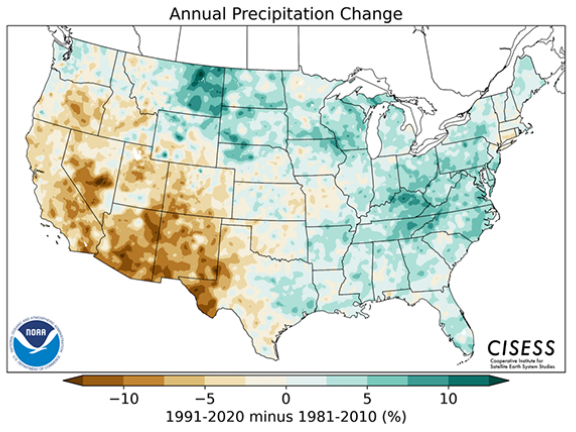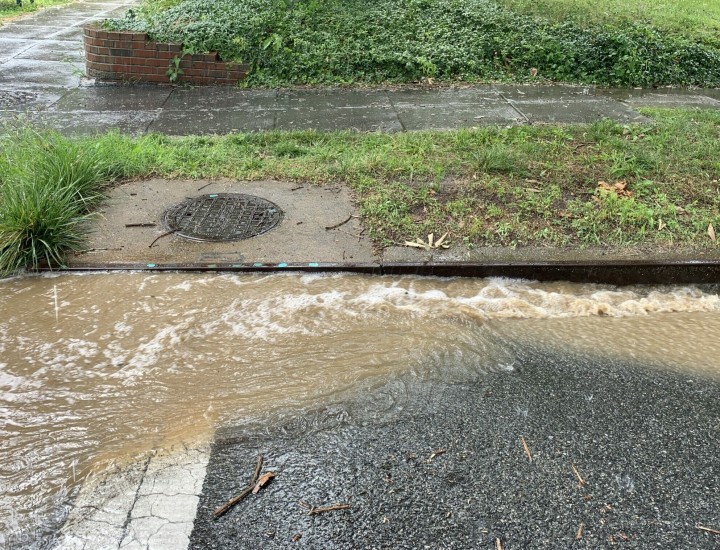Startling Surge in Annual Rainfall Levels Demands State Action

Evan Isaacson, Chesapeake Legal Alliance
Last month, the National Oceanic and Atmospheric Administration (NOAA) released the latest installment of its “Climate Normals” dataset. In the headline of its press release, NOAA asks, What do the data tell us about climate change?
The dataset does what it sounds like: it provides a value representing average temperature, precipitation, and other climate conditions over a 30-year period. The previous release covered the period between 1981 and 2010. The latest one describes conditions between 1991 and 2020 and also enables users to examine more recent data (from the 15-year period between 2006 to 2020).
When the new data were released, we at the Chesapeake Accountability Project (CAP) immediately examined it to take a look at what the “new normal” means for precipitation levels in Maryland.
At CAP, we’re working to restore the Chesapeake Bay and one of our chief concerns is that states are appropriately managing stormwater pollution — rain and snow that collects toxins as it runs off pavement in urban areas and other industrial sites. We’ve compiled our research about the effects of stormwater pollution on water quality and public health and provided it to the Maryland Department of the Environment (MDE) as it reviews and updates its construction, industrial, and municipal stormwater permits. This has been our most time-consuming endeavor to date.
Climate change has loomed large in this work because more precipitation means more stormwater pollution. That’s why the first thing we examined in the new data was whether, and to what extent, annual precipitation levels changed. Using data from the Baltimore-Washington International (BWI) Airport’s long-term weather monitoring station, we compared annual precipitation levels for the 1981-2010 period and the new 1991-2020 period, as well as the latest 15-year period from 2006-2020.
A Startling Surge
What we found was startling.
Many Marylanders might guess that rainfall has increased lately. We assumed the same, given what we’ve learned from recent data releases by NOAA and the Fourth National Climate Assessment, a massive federal interagency report released in 2018 that analyzes the effects of climate change.
We also assumed that the most substantial changes in precipitation patterns have related to intensity; in other words, we thought we were mostly seeing more short bursts of heavy rains, including those that cause massive damage, such as the storms that recently battered Ellicott and Baltimore cities. In other words, we expected to see the biggest changes to hourly precipitation totals, not to averages over an entire year.
Instead, we found that annual rainfall totals at BWI increased by nearly five and a half inches from the 1981-2010 period to the 2006-2020 period. This is an astounding rate of change in a climatological blink of an eye. Such a sudden surge demands attention from state and federal leaders and should compel immediate action.
In particular, MDE must ensure that programs responsible for mitigating damage from flooding and stormwater pollution are properly adapted to this new climate normal. We argued precisely that in public comments we recently submitted to MDE regarding the state’s three major stormwater related permits.
More Rain Means More Pollution
In our comments, we felt compelled to state the obvious: that more rain means more stormwater, which, in turn, means more pollution. Doing nothing is simply not an option.
We did not have access to NOAA’s latest data when we submitted our comments, but there has been no shortage of other pertinent data over the last decade. Moreover, one does not need to be a data analyst to sense that storms in Maryland are getting much worse and to understand that more water means more flood damage, more basement backups, and much more pollution, especially in urban areas, where water has nowhere to go.
MDE must not only acknowledge that climate change isn’t a hoax but also do something about it. We asked it to strengthen Maryland’s stormwater permits; instead, the agency is proposing to weaken several of the permits by removing the very requirement designed to reduce stormwater from urban and industrial areas.
We hope NOAA’s latest climate data are a wakeup call to MDE — and to Maryland residents. If not, we’ll be stuck with the same old policies while the climate continues to change, harming Marylanders and our environment.
